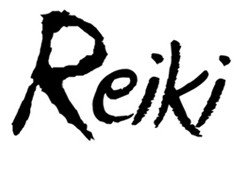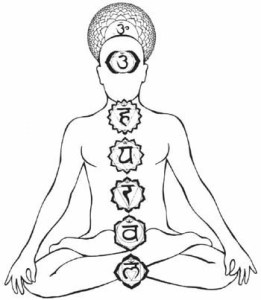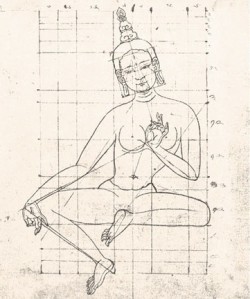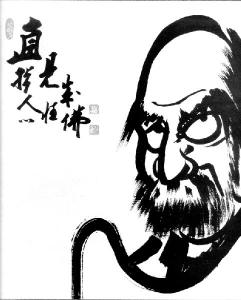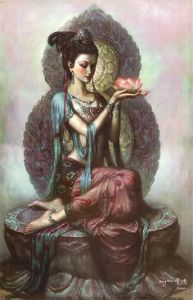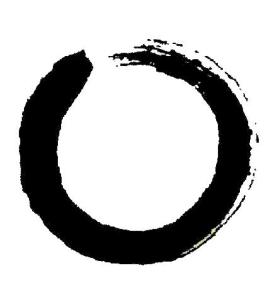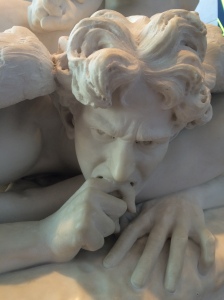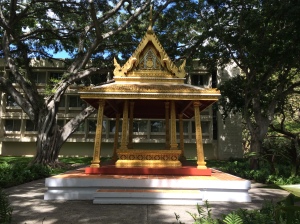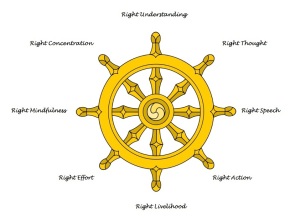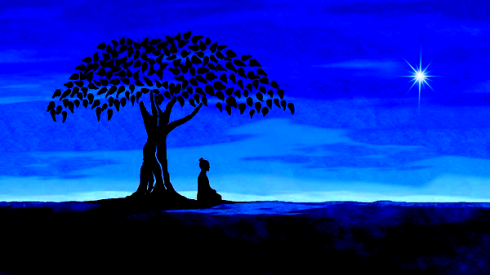
In-Tension
The tradition of Ch’an/Zen Buddhism is steeped in iconoclasm. From Bodhidharma’s “special transmission outside the scriptures” to Lin Chi’s comparing the Buddha to “the hole in a privy,” Zen Buddhism has always been a maverick amongst its more conformist siblings. Yet, what are we doing here?! Are we not referencing a revered tradition in our very observation of that tradition’s upending of traditions?! In that moment of realizing the paradox, it’s as if we can hear every trickster guru from Shakyamuni down to Alan Watts chuckling at our confrontation with upaya (cunning means of education).
We are not here to be the butt of their joke, however. We are here to grapple with a dynamic at play between accreditation and appropriation, legitimacy and interloping, trappings of Zen and true Zen.
Though not a new quandary, as of late a number of articles have explored these largely American questions. The Magazine Buddhadharma dedicated its Summer 2015 issue to these matters. In 2014 Joshua Eaton wrote an article for Solon magazine on the appropriation of Buddhist dharma by “mindfulness” movements, particularly in and among the corporate culture elites. And NPR’s “All Things Considered” ran a story in September 2015 on San Diego State University’s fledgling Buddhist fraternity and sorority. That’s a short list of more than dozens of articles that were recently published on this topic.
The fundamental question that these various articles are asking is: What is Buddhism and whose Buddhism is it? I say that this is largely an American question because, though Buddhism’s history is one of transplantation – from India to China, China to east Asian countries, including Japan, and from there to the West – today, we Americans are putting a uniquely American spin on the age-old question of authenticity.
Twenty-first Century America repeats like a mantra, “Have it your way.” We choose our news and entertainment on-demand. We order customized sneakers made across the globe to our exact specifications and have them delivered in a matter of days. It makes sense that we’d want our Buddhism to be à la carte.
But, as my professor, Jon D. Levinson of the Harvard Divinity School, used to say so frequently in teaching about Judaism and its rules, commandments, traditions, and interpretations, “A canon is not a smorgasbord.”
The appropriation of Buddhism in America today is more insidious than simply picking and choosing aspects of the religion that we like, find appealing, or helpful. With the rise of “mindfulness” and “self-help” movements distilling the “beneficial” aspects of Buddhism and (other traditions) down to the “essence” without the “accoutrements” of the religion, rituals, traditions, and cultural specificities, there is a threefold danger: 1) the danger of displacing the central message of Buddhism (anatman, “no-self”) and replacing it with me me me; 2) the danger of an externally originated reductionist evaluation of Buddhism; 3) the danger of distorting Buddhism and/or diluting its unique identity until it lacks any and all identifying features.
Each and every day we hear more and more about the health, wealth, and wisdom to be gained from “mindfulness.” From the Dalai Lama’s collaboration with M.I.T. and Harvard on the “scientifically proven” benefits of meditation, to Jon Kabat-Zinn’s Mindfulness-based stress reduction, to Marsha Linehan and others who have incorporated meditation and mindfulness into Dialectical Behavior Therapy (DBT), aspects of Buddhism have been incorporated, appropriated, and lauded as therapeutic in the West in a rising tide of health-conscious seekers for the solution to the stresses of modern living.
Westerners are practicing meditation and mindfulness, surgically selecting aspects of age-old traditions that suit their current needs, just as yoga has frequently been transformed into a workout designed to be a stress-reducer, without reference to or concern for the rich and deep spiritual and religious tradition of which it is a part.
Just as so many Westerners are searching for “spirituality” without religion, so too have Western Buddhists sought satori without rituals.
We could, provisionally, divide “Buddhist practitioners” into two camps: secularists and traditionalists. The former could say, “What’s wrong with taking what works for me and leaving the rest behind? The Buddha himself preached, ‘Do not accept any of my words on faith, believing them just because I said them. Be like an analyst buying gold, who cuts, burns, and critically examines his product for authenticity. Only accept what passes the test by proving useful and beneficial in your life.’” (Jnanasara-samuccaya)
The traditionalist could respond, quoting Shakespeare, “The devil can cite Scripture for his purpose,” just as Satan did in Matthew 4:1-11. Or, paraphrasing Robert Frost, the traditionalist could retort, “‘Mindfulnesss’ without Buddhism is like playing tennis without a net: It’s fun, but it’s not tennis. It’s helpful, but it’s not Buddhism.”
But beyond these objections, there is a greater danger. Just as the secularist invoked an authority (the Buddha himself) in order to legitimize the secular view, the rejection of tradition opens the bulwarks of the religion to being coopted, appropriated, even perverted by “false prophets,” false preachers, false teachers of the Dharma. The authenticity of the religion is put into jeopardy by the potential for illegitimate, unaccredited interlopers to propound “the Dharma” as they see it.
Whether we are talking about a religious practice or a judicial practice, what a canon offers is certain long-standing, time-tested, limits on interpretation and advancement of the tradition in question. As such, just as in Plato’s ideal city, the fundamental principles of any tradition rest on the guardians of the canon.
On the other hand, institutions and centers of authority run the risk of becoming entrenched in their own bureaucratic bulwarks. Time and time again we see in well-established religions ossification and corruption amongst the accredited elites followed by a reaction and rejuvenation among marginal figures. For instance, the Cluniac reforms and St. Francis of Assisi challenged the decadence and corruption of the powerful within the Catholic Church. Martin Luther attempted reform and found that the tradition was so rigid it needed to break.
This tension between tradition and reform, between authority and the maverick is concisely sketched by Robert M. Pirsig, quoting A.E. Hoebel when he says:
[T]he priesthood fights an unrelenting war against shamans….Priests work in a rigorously structured hierarchy fixed in a firm set of traditions. Their power comes from and is vested in the organization itself. They constitute a religious bureaucracy. Shamans, on the other hand, are arrant individualists. Each is on his own, undisciplined by bureaucratic control; hence a shaman is always a threat to the order of the organized church. In the view of the priests they are presumptive pretenders. Joan of Arc was a shaman for she communed directly with the angels of God.
Without the shamans or “presumptive pretenders,” the form is in danger of being dedicated to perpetuating its own existence, rather than a commitment to the original vision and mission that brought it into existence in the first place. It could grow stale, a fossil, dead weight lacking the dynamic force that is necessary for an institution to be in the service of life and vitality.
Shamanistic reform can be of two types: one, pushing the tradition forward in the face of new, unprecedented challenges; two, returning the tradition to its origins in the face of decadent deviation from its roots.
The former is exemplified by the Buddha himself. Born into Hindu tradition, religion, and society, he incorporated much of the religious, social, and philosophical milieu, but he also upended it essentially, vertically, and horizontally. By that I mean, he transformed the central formula of the Upanishads from atman Brahman (you, yourself, are the Supreme Deity, Brahman) to simply anatman (there is no self). Vertically – in terms of the strict hierarchical caste system, he opened up the possibility of nirvana to everyone and anyone, not just the highest priestly caste. And horizontally – he did away with the stages of proper roles according to age (student, householder, semi-retired/semi-spiritual, fully-retired/fully-spiritual practice), and said that anyone at any time can become enlightened. These three heterodox doctrines responded to the rigid Hinduism of his time in the face of a new set of problems in the time of the Buddha.
The latter shamanistic reformer can be seen in the figure of Dogen, who, dissatisfied with the Zen Buddhism of his day in Japan, went back to the sources in China to rediscover its more authentic origins.
Both of these forms of reform can be considered “radical” (the root meaning of which is “root”). The former, in that it is radically breaking from tradition, pulling the tradition up by the roots, as it were. The latter in that it is returning to the roots of the religion in order to revitalize it.
Placing too much faith in the accrediting body (the word “accreditation” itself being derived from the Latin credo – belief, faith) runs the danger of perpetuating formality over vitality. But disregarding the structures that confer legitimacy (root word lex, legis, meaning “law,” “lawful”) runs the danger of distortion and dissipation of the Dharma (one meaning of which, is “law”). Furthermore, the transformation of Buddhism into “mindfulness” is worse than dilettantism, it is to appropriate a venerable tradition and coopt it into serving one’s own purposes and needs.
What we find in modern, particularly American, “mindfulness” practices, from Jon Kabat-Zinn onward, is a notion of transcending the parochial and sectarian “muck” of religion, particularly Buddhism, just as Buddhism uses the metaphor of the lotus lifting and blossoming out of the “muck” of the pond. Though this transcendent mindfulness attempts to leave behind the trappings of Buddhism in general and Zen in particular, the seeds of this transformation can be found in the early advocates of Zen in the west, namely in D.T. Suzuki and Alan Watts, among others. There is, in their writings, a strain of “essentialism,” or purity – a biased and subtle notion that Zen, of all the world’s religions, is the most transcendent and universal.
This essentialist idea can still be detected in a modern defense of the tradition. In her article, “Don’t Strip It All Away,” in Buddhadharma Magazine, Gesshin Greenwood relays the following story:
Last year during a public question-and-answer session at Nisodo, the Soto Zen training monastery for women in Japan, a German nun asked the abbess, ‘How much of the practice here is Japanese culture, and how much is true Buddhism?’ The abbess, Shundo Aoyama Roshi, answered with a metaphor she often uses in dharma talks and writings: Buddhism, she said, is like a wheel turning. The outside of the wheel is everything that depends upon time and place–culture, forms, language. As the wheel makes its way across cultures and time periods, the outside moves and changes. However, the inside, which is the true buddha-dharma, stays the same in every place. It takes a lifetime of practice, she says, to be able to identify what is at the center and what is on the outside. (p. 35)
This lovely little analogy, complex as it may be, does suggest an essentialist, “true Buddha-dharma” that is transcendent to time and space. Of course, as Brad Warner of “Hardcore Zen” points out in his commentary on this article, “The wheel can’t move forward without its rim.” (July 13, 2015, “Form vs Essence”) We can go further and say that without the rim there is no center. But the bigger point is that Buddhism is staunchly anti-essentialist. The notion of anatman, no-self, could also be understood as no essence to anything. There is only dependent arising. There are no absolute truths within the world of dependent arising, only relative ones, dependent ones. Those truths are dependent upon the time, the place, and the relationship of the subjects involved. Again, as so often in Buddhism, we find ourselves running up against the limits of logic and language. Here, the paradox is that Buddhism is, “essentially,” non-essentialist and therefore it follows that there is no “essential” or “true” Buddhism either.
But that doesn’t mean that it’s anything goes. Buddhism is “staunchly” or dogmatically or doctrinally non-essentialist so long as one is in a relationship with a religion that one feels the need to pin it down. In other words, what Buddhism “is” depends upon who you are (how you understand yourself) and what Buddhism is to you (your needs, your ability to understand and realize). As the Buddha has said, once the raft (here, a symbol of the religion of Buddhism) has been used to transport one from the dangerous shore to the safe shore, then the raft is no longer necessary. The raft (doctrine, dogma, concepts) can be discarded once its purpose has been served.
But don’t be so quick to determine that you have arrived safely upon the nether shore!
Perhaps that is the fatal flaw of the mindfulness movement – that it is too eager to believe itself well beyond the need for such “primitive” rituals and practices. There is an ego-aggrandizement to be found is such a stance and that ego-centeredness is only fed by the supposed benefits to be reaped through mindfulness – happiness, productivity, wealth, prosperity, health, and a better you!
The fact is, just as Buddhism is anti-essentialist – a stance that decenters our conceptions of the world around us – through that negation of essence, selfhood, and ego, it also decenters us from being the subject and object of our practice. One doesn’t meditate to be better. One doesn’t meditate to do more, be healthier, happier, or for any other purpose. That’s just the point – that there is no point! There is no reward to be reaped through the diligent effort.
However, this is just scratching the surface of the underlying cultural prejudices that are violently glossed over when meditation and mindfulness are practiced in a Western paradigm of enhancing productivity. E.F. Schumacher, in his article, “Buddhist Economics,” has pointed out that in the West there is a long-standing cultural distinction made between work and leisure. And it is with this underlying cultural assumption that we find surprising common ground between Adam Smith and Carl Marx. Both of them see “work as little more than a necessary evil.” They have different ways of maximizing production or maximizing leisure, but they share this cultural predisposition of a dichotomy that goes as far back in western culture as Adam and Eve.
In Buddhism, however, there is no dichotomy between these two concepts. One doesn’t work for the sake of leisure, nor is leisure, in itself, desirable and work undesirable. Rather, the “dull” and “mundane” tasks of work take on a sacramental quality. They are not done for reward, but rather, as in play, the reward is in the doing.
As the philosopher David E. Storey has pointed out, one can approach one’s activities with the mindset of rut, routine, or ritual. A rut is something that one dreads doing. It takes all of one’s effort just to do it and one often resents the activity. A routine is an act that is done mindlessly. One has neither aversion to it nor cherishes it. And a ritual is an act that is performed for the sake of its performance. One approaches it with awe and devotion. In the West, ritual and this mind-set is usually reserved for acts relating to the sacred. (Or, perhaps, they used to be, but now such sacred acts such as church-going and holy-day obligations are performed at best as routines, and at worst as a rut.) But in Buddhism, every act, no matter how small or how “ordinary,” is undertaken with the mind-set of ritual. That is what mindfulness in the Buddhist context really means. (Note that “ordinary” is etymologically related to “order,” as in a religious order, as well as “ordain,” to make something consecrated, holy.)
One reason that westerners have been so enthusiastic about mindfulness and a possible explanation of its popularity, especially among the wealthy, urban elite, could have to do with this desire in the West to flee the ordinary. As Slavoj Žižek has pointed out in his essay, “From Western Marxism to Western Buddhism,” westerners have long searched for the more exotic in origin of mystery cults rather than the native fruits. (Cabinet Magazine, Issue 2, Spring 2001) A meditative practice with origins in Buddhism from Asia, but in the relatively unimposing form of mindfulness, is more preferable to a western audience than the relatively closer-at-hand tradition of Catholic contemplation. (In the Catholic tradition “contemplation” is the non-verbal, non-imagistic form of prayer, contrasted with “meditation,” which involves positive images and discursive thought.) And, as Žižek points out, this “mindfulness” not only has the cache of exoticism, but it also upholds the status quo while at the same time unburdening the practitioner of any guilt by association with the great inequities of Capitalism. Thus, rather than disrupting and decentering (the tradition, the self, the system), there is a danger that mindfulness could mindlessly reinforce all of the egoistic constellations, easing us into complacency.
Perhaps, despite the great popularity of the Dalai Lama in the U.S., it is in order to counter this fetishism and searching for something else that he cautions, “Don’t try to use what you learn from Buddhism to be a better Buddhist; use it to be a better whatever-you-already-are.” (Source unknown) Perhaps, in the final analysis, this saying sums up best the uses and abuses of Buddhism. By that I mean that the Buddha, in and through his life and teachings, and Buddhism, as an emulation of the Buddha, are both generous and not rigidly doctrinal. A collection of Alan Watts’ essays is entitled, Buddhism, the Religion of No-Religion, and much can be gleaned from that title in conjunction with the parable of the raft. The starting point of Buddhism is that we suffer. In that sense, we are stuck in the pits. Buddhism can be used (and has been used by such folks as Jon Kabat-Zinn) to help one with great and small suffering alike. Buddhism also offers much by way of practical advice and pragmatic approaches to trenchant metaphysical and philosophical problems. In this way, Buddhism speaks to the plains – the day-to-day concerns of life such that the Noble Eightfold Path is a helpful guide. Finally, Buddhism points to and encourages us to climb the peaks – to have “peak experiences” in every moment. But, unlike many western religions that make themselves indispensable to the individual for purposes of salvation, Buddhism preaches not salvation but liberation and that liberation entails liberation even from the attachment to the religion itself. Zen, in particular, preaches that you, as you are, are already enlightened, a Buddha, and not in need of salvation or improvement. All you need to do is accept it. In its generosity and focus on the individual, not the religion, Buddhism says, “Here, take this if you wish, if it helps you, if you can use it. If not, that’s ok too.” In Buddhism’s great generosity, it doesn’t staunchly defend its “turf,” jealously guarding its techniques as if protected by copyright, patent, or trademark. And, in that sense, perhaps all the recent hullabaloo about appropriation of Buddhism by mindfulness is just balderdash. To some extent, that would include this very writing itself, though I hope to encourage mindfulness to be more mindful of what it is actually doing.
So, to return to our original story, the special transmission outside the scriptures implies three very important features that are pertinent to the topics we’ve discussed herein: 1) It focuses on the interpersonal, relational, and contextual conferral of the dharma seal; 2) It simultaneously upholds and disrupts the tradition; 3) It is not a doctrine, dogma, or system.
As we mentioned, Buddhism makes no claims to absolute Truth, but rather only conditional, dependent truths. As the “Flower Sermon” illustrates, the authentic, legitimate, stamp of accreditation occurs only by “pointing directly to one’s mind” and “seeing into one’s true nature.” In other words, don’t pretend to be something you’re not. There is a great story about this in which Ananda, the Buddha’s hand-picked chosen successor to lead the Sangha, knew that he was not enlightened. When it came time for him to lead the first meeting of the Sangha after the Buddha’s death, he stayed up all night trying to become enlightened so that he wouldn’t be seen as a fraud before the congregation. Finally, after much sweat and anxiety, only moments before the meeting was to come to order, alone in his room he conceded, “Oh well, I’m not enlightened.” And by virtue of seeing and accepting things as they were, he became enlightened at that moment.
With regard to a tradition, it is true that a canon is not a smorgasbord, but it also isn’t fixed. Canons do change. The notion of a compulsory canon is only for cocktail party intellectuals. As with an individual painting, for instance, the history of the painting, its deterioration, the damage it incurred over time are as much a part of the art as the original, pristine image – if, in fact, there was an original. So too with canons – whether literary, religions, judicial – canons change across time and space. They provide certain internally generated limits and guides, but they are not inflexible. Of the religious canons, it could be said that the Buddhist canon in general and the Zen canon in particular are the most flexible, even to the point of canonizing perpetual revolution.
In this sense, Buddhism, and certainly Zen, is not doctrinal, dogmatic, or systematic. In many respects, Buddhism shares the sentiment of Jesus when he said to the Pharisees, “the Kingdom of Heaven is within you.” (Luke 17:21) Saying The Kingdom of Heaven is within you is a subversive idea since one who knows and experiences this owes no allegiance to any established institution or church. And, quite the contrary of the Unitarian Universalists, who attempt to bring every tradition into one church, this suggests the ability to feel at home in any and every church. When all traditions are jumbled into one (as with the Unitarian Universalists), the unique is sacrificed for the universal. By the same token, when the distinctive qualities of any tradition are filtered out (as with mindfulness), then the beauty of medium is sacrificed.
One could use a few analogies to illustrate these points. As with food, the former approach is like putting every and all ingredients into a pot and creating a stew that, because it lacks a time-tested recipe, ends up tasting like nothing in particular. The latter approach reminds me of the nutritional paste represented in The Matrix. Or with alcohol – the former is like mixing every drink together resulting in an unpalatable cocktail and the latter is like these new alcohol vaporizers that introduce alcohol directly into the blood stream via inhaling it. It may produce the intended result of intoxication, but without the pleasant, tasty medium of the fine wine, aged whiskey, or perfectly blended mixed drink. Or finally, the metaphor of language: The former approach is like rambling prose, the latter is like summing up the Iliad into a few sentences that say, “Guy takes girl and has temper tantrum when girl is taken from him. People die.” Somehow that misses the beauty and texture of the poetry itself.
On the other hand, even if you are a virtuoso of the spirit and feel at home in any and every place of worship, that doesn’t mean that any and every tradition welcomes you as one of their own. Nor should they. You may be a game master, even a maker of games or game theorist, but that doesn’t mean that you, as a player-participant, are not bound by the rules of the specific game you are playing. To be a master gamer not only entails understanding and seeing the hidden connections between different kinds of games, mapping the meta-rules that organize and undergird all games, but also being able to play a particular game according to its own limited rules. And sometimes those rules exclude you as a participant. Respecting the rules of the game is part of what being a master means.
There is more than just metaphor to the image of a “game master” as relates to religion. But, suffice it to say for now that just as the master gamer sees, finds, and makes a game of all things – all things become play-things – so too does the spiritual adept feel every place as sacred, all time as holy, all things as God incarnate. Incipit Magister Ludi.
To learn more, please visit: http://prosperoproductions.com/zen_sangha
Tags: Buddhism, freedom, games, ideas, law, Life, Meditation, mind, philosophy, play, psychology, Religion, rules, Zen



